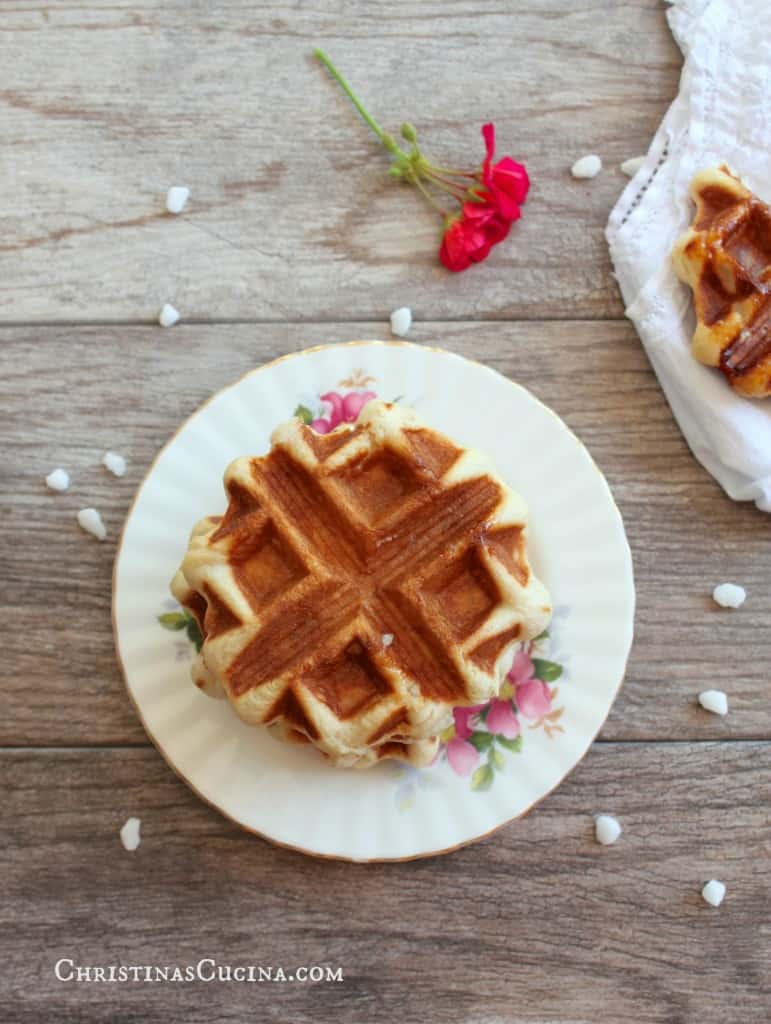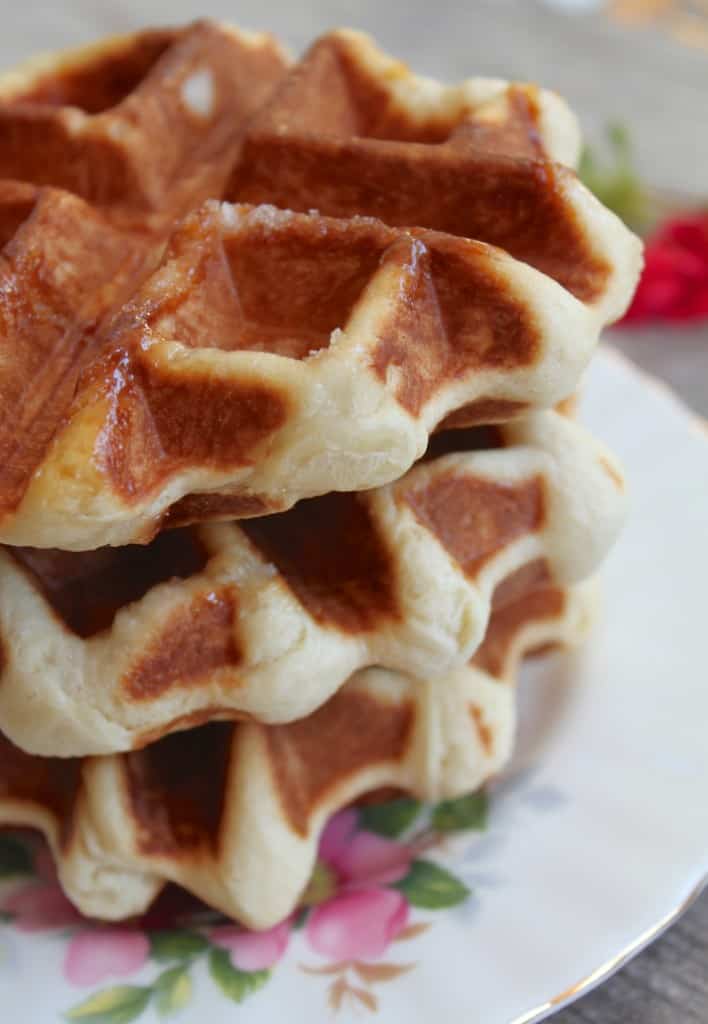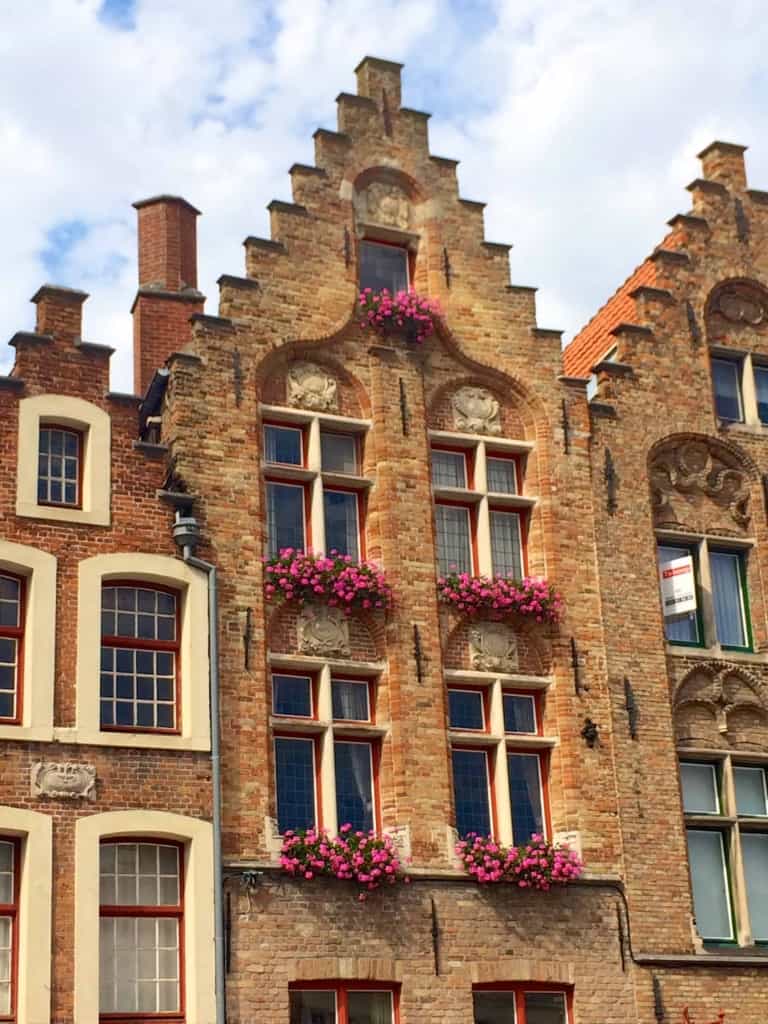Liege Waffles (Traditional Belgian Waffle Recipe) – a Day Trip to Bruges!
Liege waffles are so much different than America’s version of Belgian Waffles. Learn the difference, and taste traditional, authentic Belgian Liege waffles with their heavenly bits of caramelized Belgian pearl sugar and you’ll never look back!

These Liege waffles are super lekker!
Oh, I’m sorry, you don’t speak Dutch?
Neither do I, but I learned the term “super lekker” from my cousin’s four year old daughter when I was visiting in Belgium last month.
As an Amazon Associate I earn from qualifying purchases.


“Super lekker” translates to “super tasty” in English, and that’s exactly how to describe these authentic Liege waffles!
What is the Difference Between US Belgian Waffles and Authentic LiegeWaffles?
First of all, if you’re like me, you probably think these are sort of like our American breakfast waffles, right? Well, I was so far off base on this: you can’t imagine what a difference there is between the two, so let me explain the differences. Belgium has a few different types of waffles, but mainly Liege and Brussels waffles (made with yeast, and lighter than the Liege-style).
- Authentic Liege waffles are not made with a batter, but a yeast dough.
- Authentic Liege waffles have a completely different texture than American Belgian waffles.
- Instead of eating them with a knife and fork, authentic Belgian waffles (from both Liege and Brussels) are usually eaten handheld.
- Authentic Liege waffles are not solely for breakfast and are often eaten without a topping or sauce.
- One of the biggest differences is that Liege waffles have pieces of caramelized pearl sugar in them!

It’s not a surprise that as Americans we are so misled as there are a lot of “Belgian Waffle” recipes out there which do not resemble anything like the real Liege waffles and are also different than Brussels waffles. Even a very prominent and popular flour company has a recipe for “Belgian Waffles” on their site, which is made with a batter. They should probably be called American-Belgian waffles. Now you know the difference, and the recipe I will be sharing with you is for the real thing: an authentic, traditional Liege-style Belgian waffle.
Visiting Bruges and Discovering Liege Waffles
When I went to Bruges last month which was my next stop after leaving London on my culinary tour of Europe, I saw waffles everywhere! Here are a few shots from my day in Bruges (you can skip to the bottom for the waffle recipe).
We went to the chocolate museum, although it’s interesting, I’d say you could skip it and check out more of Bruges if you’re short on time. (There’s also a french fry museum!) However, a boat cruise on the canals is a must as you see many more sights, and from a unique perspective.

Sights around Bruges. The boy below is made entirely of chocolate.
We had pastries from a fabulous patisserie called Patisserie Academie. I will be posting about this lovely patisserie in more depth later, with another recipe (if I can manage to recreate the amazing dessert)!

And what trip to Belgium would be complete without having some fries…
chocolates,

and beer!

But most of all, we cannot forget about the authentic Belgian LIEGE WAFFLES!
Authentic Belgian Waffles (Liege Waffles)
adapted from Piet Huysentruyt Nieuws
Makes 10 waffles
*unfortunately, I cannot add the amounts in cups as the exact measurements are critical to this recipe
I strongly recommend buying a kitchen scale for all baking
Ingredients
- 300 g all purpose/plain flour plus 200 g flour
- 80 g sugar
- 2 tsp dry yeast
- 150 ml water
- 2 eggs
- 15 g butter (room temperature) plus
- 175 g butter, cut into pieces (then allow to sit at room temperature)
- 140 g Belgian Pearl Sugar* (found at specialty stores or Amazon)
Special equipment: waffle iron (the one I have by Waring Pro has been discontinued
Make the Liege Waffles Dough
Place 300 grams flour plus the 80 grams of regular sugar in a mixing bowl. Set aside.
Warm the water until it is lukewarm (not at all hot) then add the yeast (do not add the yeast when the water is too hot or it will kill it and the recipe will be ruined) and whisk until it has melted.
Add the eggs and 15 g of butter to the flour and sugar mixture in the mixing bowl, then pour in the water and yeast mixture, whisking to combine all the ingredients.
Continue stirring until a sticky dough is formed.

Then add the 200 grams of flour to the top, along with the 175 grams of butter pieces. Cover (without mixing anything) and allow to rest for 20 to 25 minutes.
With your hands, incorporate the butter and flour into the sticky dough until all the ingredients are well combined and the dough is no longer sticky (only add a little more flour if necessary).
Roll the Waffle Dough and Fill
Place the Liege waffle dough onto a lightly floured surface and press into a 12″ x 12″ square shape, then sprinkle with the Belgian Pearl sugar (*the original recipe lists 300 grams of sugar, but I found this to be much too much-add more or less to your liking).

Now roll the dough from one end to the other, to form a large sausage shape.
Cut into 100 gram pieces and form into ball shapes and set aside to rest for 15 minutes, covered with a slightly damp kitchen cloth.
NOTE: You can cook these Belgian waffles in the iron now. However, I discovered that keeping the dough pieces in the fridge overnight, then bringing them to room temperature and then cooking them worked marvelously, too.

Cook the LiegeWaffles
Heat the waffle iron. This is the tricky part as all irons are different. I have a Waring Pro, now discontinued, and heated mine to the number 2 setting. The goal is to cook the waffle without making it too dry and overcooked, but caramelizing the sugar pieces at the same time. Play with the settings until you reach a result that you like. This is how the sugar looks once it’s caramelized.
Place a ball of waffle dough in the middle of the iron and cook it until it’s golden brown (I cooked mine at the number 2 setting for 4 minutes) and the sugar has caramelized. Don’t worry if it doesn’t look pretty.
Carefully remove the waffle as the caramelized sugar will definitely give you a nasty burn (I used a small flat wooden utensil, but wooden tongs would also work).
Serve as is, with a dusting of powdered sugar or melted chocolate (traditional serving ideas). Authentic Belgian waffles can be eaten the next day; just warm them a little first, or even put them in the toaster.
Remember, don’t expect these to taste like, or have the same texture as American waffles. Liege waffles are so delicious, but are difficult to describe as they are so different than what we are used to.
Overnight Waffles with Buttery Maple Nectarine Topping
This is what the inside of the authentic Belgian waffles looks like: not light and fluffy, but more dense and substantial. We’re missing the best of Belgium’s waffles if we don’t make traditional Liege waffles! Order that Belgian pearl sugar and get kneading! As Donkey says from Shrek, “We’re makin’ WAFFLES!”
The inside texture of Liege waffles, along with the bits of caramelized sugar is what makes them phenomenal!
All I know is, I’m hooked on these super lekker authentic Liege waffles! Let me know if you try them by leaving a comment below. Goede eetlust (bon appetit)!
Next stop on my culinary tour? Geneva, Switzerland!
Don’t miss another recipe or travel post; sign up for my free subscription below!

A Super Lekker, Authentic (Traditional) Belgian Waffle Recipe and a Day Trip to Bruges!
Special Equipment
- 1 kitchen scale
- 1 waffle iron
Ingredients
- 17 oz flour (divided into 300 g (10 oz) and 200 g (7 oz))
- 3 oz sugar
- 2 tsp dry yeast
- 5 oz water
- 2 eggs
- ½ oz butter room temperature
- 6 oz butter cut into pieces (then allow to sit at room temperature)
- 5 oz Belgian Pearl Sugar found at specialty stores or Amazon
Instructions
- Place 300 grams flour plus the 80 grams of regular sugar in a mixing bowl. Set aside.
- Warm the water until it is lukewarm (not at all hot) then add the yeast (do not add the yeast when the water is too hot or it will kill it and the recipe will be ruined) and whisk until it has melted.
- Add the eggs and 15 g of butter to the flour and sugar mixture in the mixing bowl, then pour in the water and yeast mixture, whisking to combine all the ingredients.
- Continue stirring until a sticky dough is formed.
- Then add the 200 grams of flour to the top, along with the 175 grams of butter pieces. Cover (without mixing anything) and allow to rest for 20 to 25 minutes.
- With your hands, incorporate the butter and flour into the sticky dough until all the ingredients are well combined and the dough is no longer sticky (only add a little more flour if necessary).
- Place the dough onto a lightly floured surface and press into a 12" x 12" square shape, then sprinkle with the Belgian Pearl sugar (*the original recipe lists 300 grams of sugar, but I found this to be much too much-add more or less to your liking).
- Note: this is less than half of the sugar in the original recipe.
- Now roll the dough from one end to the other, to form a large sausage shape.
- Cut into 100 gram pieces and form into ball shapes and set aside to rest for 15 minutes, covered with a slightly damp kitchen cloth.NOTE: You can cook them in the waffle iron now, however, I discovered that keeping the dough pieces in the fridge overnight, then bringing them to room temperature and then cooking them worked marvelously!
- Heat the waffle iron. This is the tricky part as all irons are different. I have a Waring Pro, now discontinued, and heated mine to the number 2 setting. The goal is to cook the waffle without making it too dry and overcooked, but caramelizing the sugar pieces at the same time. Play with the settings until you reach a result that you like. This is how the sugar looks once it's caramelized.
- Place a ball of dough in the middle of the iron and cook it until it's golden brown (I cooked mine at the number 2 setting for 4 minutes) and the sugar has caramelized. Don't worry if it doesn't look pretty.
- Carefully remove the waffle as the caramelized sugar will definitely give you a nasty burn (I used a small flat wooden utensil, but wooden tongs would also work).
- Serve as is, with a dusting of powdered sugar or melted chocolate (traditional serving ideas). These can be eaten the next day; just warm them a little first, or even put them in the toaster.
Notes
- Please use gram/ml measurements for the best results (metric)
- These waffles truly don't need anything served on or with them, they're that good.
Nutrition
A postcard from me to you!
Christina’s Cucina is a participant in the Amazon Services LLC Associates Program, an affiliate advertising program designed to provide a means for sites to earn advertising fees by advertising and linking to Amazon.com.




















We moved to Brussels 2 years ago and I fell in love with the Leige waffle! The best is when it’s a really cold day at the park and there is always a waffle truck near by where you can get a warm waffle! I love it! I will be filing this recipe away for the day we no longer live here – as I know I will be craving a waffle :)
Hi Alex, lucky you! I know how good they are and fortunately, this recipe actually will satisfy your craving and be worthy of those Belgian waffles! It’s rare to be able to recreate something outside of the city/country of origin and be happy with it!